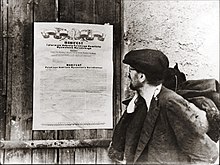Lublin Committee
The Lublin Committee , actually the Polish Committee for National Liberation (Polish: Polski Komitet Wyzwolenia Narodowego , PKWN for short) is a communist committee supported and dependent by the Soviet Union , which was founded towards the end of the Second World War and chaired by the Left Socialists since July 1944 (PPS) Edward Osóbka-Morawski ruled the area between the Vistula and the Bug occupied by the Red Army from Lublin and was transformed into the Polish Provisional Government on January 1, 1945.
The Lublin Committee as Provisional Government
- see also the main article on the history of Poland (Occupied Poland)
On July 22, 1944, Stalin founded a "Polish Committee of National Liberation" from the National Council and the Union of Polish Patriots in Chełm . After the German occupation of the city of Lublin by Soviet troops could be ended, it was proclaimed the first Polish capital of the post-war period. The committee should formally take power as soon as the Red Army crossed the Curzon Line . This happened in Lublin on July 22, 1944, and three days later the committee moved there. There, under its chairman Edward Osóbka-Morawski, it de facto formed the government of the area west of eastern Poland occupied by the Red Army .
On July 26, 1944, an agreement was signed between the Soviet Union and the committee in which they renounced direct Soviet rule over Poland. Of the Allies , only Stalin's government recognized the committee, bypassing the Polish government- in- exile in London, as the new provisional government of Poland. The government-in-exile had made itself unpopular with the Soviet Union at the latest with its indictment of the Katyn massacre .
The negotiations between the “London” and “Lublin” governments, which took place under pressure from the Allies, did not lead to an agreement. In fact, the Lublin Committee in Poland was able to rely on the structures of the Soviet Army . On January 1, 1945, the Lublin Committee renamed itself the "Provisional Government" and on January 18, it moved into the ruins of the liberated Warsaw . It not only assumed rule in Poland, but also the administration of Soviet-occupied German eastern areas in the south East Prussia , Danzig , Pomerania , eastern Brandenburg and Silesia . After the formation of a “government of national unity” on June 25, 1945, the Western Allies Great Britain and France also agreed in the Potsdam Agreement to place the East German areas up to the Oder and Lusatian Neisse , southern East Prussia and Danzig under temporary Polish administration.
Home Army and Resistance
After the Red Army had defeated the German army throughout Poland in the spring of 1945, 14 key leaders of the Home Army (Armia Krajowa, AK) were deported to Moscow, where they were sentenced to long prison terms and some were murdered. This broke the main resistance to the “sovietization” of Polish society. Against this recognizable objective, an armed resistance movement formed as early as the end of 1944 from parts of the Home Army , which continued to support the government in exile in London. In the forests of eastern Poland this resistance movement against the Provisional Government and the Soviet Army was initially a serious armed force . In the years after the end of the war, the partisans were estimated to have up to 100,000 members. Their actions ultimately remained fruitless and decreased from the end of the 1940s, as the Red Army, the NKVD and the emerging organs of the communist-Polish state took massive military and legal action against them.
Members of the PKWN
- Edward Osóbka-Morawski (Socialist Party PPS), chairman, responsible for foreign policy and agriculture. In the subsequent Provisional Government Prime Minister , 1944–1947.
- Wanda Wasilewska ( PPR ; Communist Party and Association of Polish Patriots in the USSR, ZPP), deputy, never returned to Poland.
- Andrzej Witos ( SL )
- Stanisław Kotek-Agroszewski ( SL "Wola Ludu", SL-close )
- Stanisław Radkiewicz (PPR)
- Jan Stefan Haneman (RPPS)
- Stefan Jędrychowski (PPR)
- Jan Michał Grubecki (SL)
- Wincenty Rzymowski ( SD - Democratic Party), temporary foreign minister
- Michał Żymierski (PPR)
- Emil Sommerstein (independent)
- Stanisław Skrzeszewski (PPR)
- Bolesław Drobner (PPS)
- Jan Czechowski (SL "Wola Ludu")
See also
- Polish underground state (after Jan Karski ; especially Polish resistance 1939–1945)
- Ludowe Wojsko Polskie (LWP, Polish People's Army) - Armia Ludowa
- Polish armed forces
- Polish Armed Forces in the Soviet Union ( Polskie Siły Zbrojne w ZSRR )
- Expelled soldiers
- Rząd Tymczasowy Rzeczypospolitej Polskiej (RTRP) - 1945 (Provisional Government, dependent on Moscow)
- Tymczasowy Rząd Jedności Narodowej (TRJN) - 1945/47 (Government of National Unity)
literature
- Dariusz Baliszewski, Andrzej Krzysztof Kunert: Ilustrowany przewodnik po Polsce stalinowskiej: 1944–1956. T. 1, Wydawnictwo Naukowe PWN , Warszawa 1999, ISBN 83-01-12906-9 . (Polish)
- Norman Davies : God's Playground . 2 vols. Columbia Univ. Press, New York 1982, ISBN 0-231-05353-3 and ISBN 0-231-05351-7 . (engl.)
- Brigitte Jäger-Dabek: Poland: a neighborhood customer for Germans. Ch. Links Verlag, 2006, ISBN 3-86153-407-X .
- Manifesto of the Polish Committee of National Liberation of July 22, 1944 (online)
Individual evidence
- ↑ Heiner Timmermann (Ed.): Potsdam 1945. Concept, tactics, error? , Documents and writings of the European Academy Otzenhausen, Berlin 1997, ISBN 3-428-08876-X , p. 133f.
Web links
- How Poland was betrayed. In: Der Spiegel . 52/1980.

